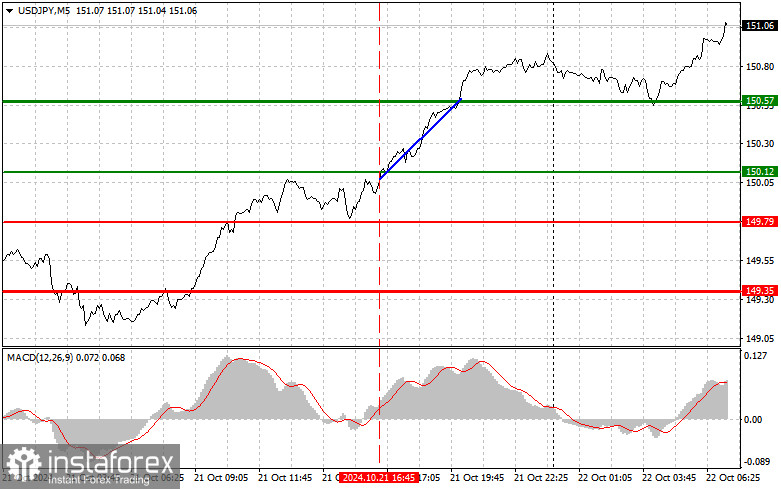Analysis of Deals and Trading Tips for the Japanese Yen
The test of the 150.12 price occurred when the MACD indicator started to move upward from the zero mark, which confirmed a valid entry point for buying the dollar. As a result, the pair rose by more than 40 pips, reaching the target level of 150.57. A series of statements from American policymakers indicated that rate cuts in the US would be less aggressive than expected, leading to dollar buying and another sell-off of the Japanese yen. Traders took advantage of the pair's dip observed in the first half of the day and quickly increased their long positions. Today, with the absence of fundamental data from Japan, the dollar's rise may continue, as numerous statements are expected from central bank representatives advocating for aggressive policy easing, unlike the Federal Reserve. I will focus on implementing Scenarios #1 and #2 for the intraday strategy.

Buy Signal
Scenario #1: Today, I plan to buy USD/JPY when it reaches the entry point around 151.30 (green line on the chart), targeting a rise to the 151.99 level (thicker green line on the chart). At around 151.99, I plan to exit the buy positions and open sell positions in the opposite direction (aiming for a movement of 30-35 pips in the opposite direction). The pair's growth can continue, but it is better to buy on pullbacks. Important! Before buying, ensure that the MACD indicator is above the zero mark and starting its upward movement.
Scenario #2: I also plan to buy USD/JPY today in case of two consecutive tests of the 150.78 price when the MACD indicator is in the oversold area. This will limit the pair's downward potential and lead to an upward market reversal. A rise to the opposite levels of 151.30 and 151.99 can be expected.
Sell Signal
Scenario #1: I plan to sell USD/JPY only after the price breaks below the 150.78 level (red line on the chart), leading to a quick decline in the pair. The key target for sellers will be the 150.14 level, where I plan to exit the sell positions and immediately open buy positions in the opposite direction (aiming for a movement of 20-25 pips in the opposite direction). Pressure on the pair will return if there is weak activity around the daily high. Important! Before selling, ensure that the MACD indicator is below the zero mark and just starting its downward movement.
Scenario #2: I also plan to sell USD/JPY today in case of two consecutive tests of the 151.30 price when the MACD indicator is in the overbought area. This will limit the pair's upward potential and lead to a market reversal downward. A decline to the opposite levels of 150.78 and 150.14 can be expected.

What's on the Chart:
Thin Green Line: The entry price at which the trading instrument can be bought.
Thick Green Line: The estimated price at which take-profit orders can be set, or profits can be manually secured, as further growth above this level is unlikely.
Thin Red Line: The entry price for selling the trading instrument.
Thick Red Line: The estimated price at which take-profit orders can be set, or profits can be manually secured, as further declines below this level are unlikely.
MACD Indicator: Considering overbought and oversold zones is crucial when entering the market.
Important Note for Beginners:
Novice traders in the Forex market must be cautious when making market entry decisions. It is best to stay out of the market before the release of major fundamental reports to avoid getting caught in sharp price movements. If you decide to trade during news releases, always set stop-loss orders to minimize losses. You can quickly lose your entire deposit without stop-loss orders, especially if you do not use money management and trade with large volumes.
And remember, successful trading requires a clear trading plan, like the one I've presented above. Spontaneous trading decisions based on the current market situation are inherently a losing strategy for an intraday trader.





















